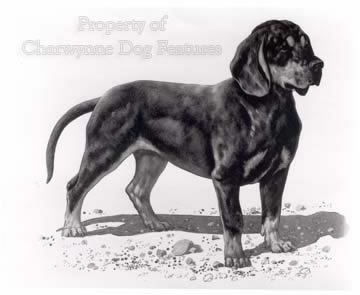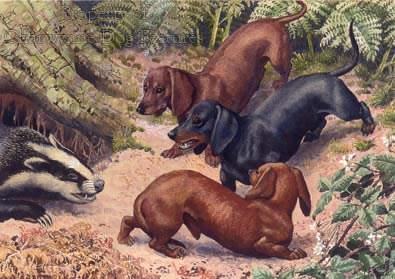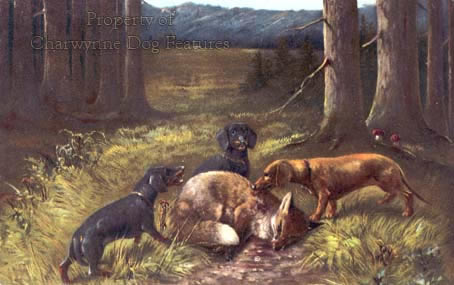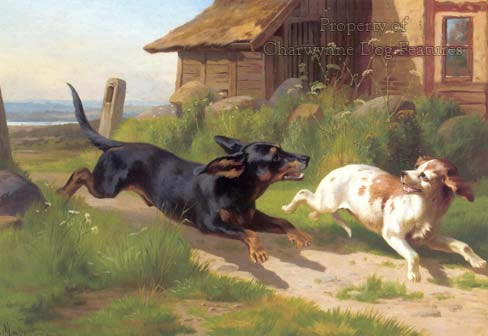141 THE SPORTING DACHSHUNDS
THE SPORTING DACHSHUNDS - The Teckels
by David Hancock
 The Badger Dog and the Badger Hound
The Badger Dog and the Badger Hound
I have written that terriers as earth-dogs are very much a British creation, although pinschers and schnauzers, and especially the German Hunt Terrier, are terrier-type. But the Dachshund, classified by the Kennel Club as a hound, (perhaps mistakenly believing 'hund' to be our word 'hound' whereas it means dog; the German word for hound is bracke), in its working role or Teckel use, is very terrier in function. Much is made in show dog histories of the Dachshund of clandestine terrier blood infusions, especially the Dandie Dinmont contribution, but I can find no proven use of terrier blood in the creation of the Dachshund. The development of the wire-hair was aided in 1925 from Dandie blood by Lt Klaus Graf Hahn of Potsdam. But the centre of working use was the Harz mountains, where Dachswurgers (badger-destroyers) were treasured and reference to a Lockhundlein or little decoy dog intriguingly made.
What is far more compelling is a descent from German foothounds, like the Dachsbracke. In the early 1800s, a Prussian forester called von Daacke was increasing the Dachshund's scenting ability by outcrossing to his Hanoverian Schweisshunds, producing red dogs with black masks and an eel stripe along their backs. Small foothounds were favourite sporting dogs in western and central Europe in past centuries: the Drever in Sweden, the Steenbrak in Holland, the Sauerland Hound or Steinbracke, as well as the Dachsbracke, in Germany and the Jura Niederlaufhund in Switzerland. There is a variety called the Alpine Dachsbracke, found in the Erzgebirge Mountains near the Czech border, known locally as the 'Erzgebirgler', usually in a rich tan. Most of the Swiss hound breeds have a smaller shorter-legged niederlaufhund variety, illustrating the genetic tendency in these foothounds. Our English Basset, bred by the packs and the result of a Harrier outcross, is our equivalent hunting hound.
As the Basset Hound demonstrates, these small hounds can throw crooked-legged dwarf offspring, with the show ring favouring the latter and sportsmen going for the straight-legged variety. The Dachsbracke, or Badger Hound, represents the latter, the Dachshund or Badger Dog representing the former. Crooked-legged dwarfism is a genetic freak, an abnormality called achondroplasia, inherited recessively. As breed depictions indicate down the years, such a genetic sidetrack in time exaggerates itself, leading to the harmful elongated backs and the disabling legs of the show ring specimens. In the Dachshund front, the whole forehand structure is reduced in length of bones; the elbow action arc being actually above the brisket line. Not surprisingly, Dachshunds and say a sighthound breed such as the Saluki move very differently from each other. Dachshunds are the only breed with the shoulders positioned so high above the brisket or keel, as breed fanciers like to term it. The Dachshund is predisposed to intervertebral disc disease because of its conformation, with disc disease occurring in young dogs as well as a geriatric condition.
Size Matters
Described in its sporting past as a Dachskrieger or Badger-warrior, with the lower to ground specimens called Dachskriecher or Badger-creeper, any Dachshund would have to be some dog, physically and in spirit to tackle a badger. Every earth-dog needs remarkable agility to work underground, both to manoeuvre and to dig. The anatomy of the show ring specimens would preclude such activity alone. Hunt terriers tend to be 12 to 14 inches at the shoulder and weigh around 14lbs, because that is what enables their function. The ideal weight for a Dachshund is 20-26lbs, with the miniature varieties being 10lbs; not much for badgers to fear there! For a 10lb dog, practically legless and with an exaggerated weakened spine, to be called a 'badger-dog' is absurd. 'Badger-breakfast' would be more accurate!
Need for Soundness
In one of his invaluable books, RH Smythe, himself a vet and exhibitor, wrote, in The Dog - Structure and Movement (Foulsham, 1970), "So far as their spines are concerned the most unfortunate are the long-backed dogs, especially the Dachshunds. The abnormal length of spine between the wither and the croup is unsupported at its centre so that undue strain falls upon the intervertebral articulations and the intervening cartilaginous discs. It has been said that the normal life of dogs of this breed is fourteen years, but the spine is good only for five years. Although Dachshunds tend to suffer at intervals from disc trouble with temporary recoveries, the tendency is for ultimate paralysis to develop at a comparatively early age." Dog breeders shouldn’t need veterinary advice to breed soundly-constructed animals, just affection for their breed and simple humanity.
My concern over long-backed short-legged dogs, the exaggerated show specimens rather than the Teckels, relates to the strain on their spines on the move. Unlike longer-legged shorter-backed breeds, the dog's weight is not supported continuously by the legs. The hind legs are just not long enough to place the hind feet close to the fore feet, as locomotion proceeds. The spine therefore bears the weight unsupported and the consequent strain must be appreciable. Vets complain of seeing Dachshunds in their surgeries only a year old but with 'five year old' spines. 'Sausage dogs' can be endearing to many, but back pain to all is best avoided, and could so easily be, in this breed - by breeding for a shorter back and lengthier legs. It's called animal welfare!
Sporting Dachshunds
Encouragement comes in the form of the Teckel, the sporting Dachshund, so like a shorter-legged Basset Fauve de Bretagne, or chestnut Basset of Brittany, a most engaging little hound. Teckels have been used extensively for deer work, both in stalking and tracking. They were introduced to the UK in the 1970s, with the UK Teckel Stud Book Society founded in 1999. There are over 580 Teckels registered with the society to date. The Ryeford Chase is a private pack of 30 couple Griffon Vendeen Bassets and uniquely 10 couple Teckels, started in 1974 and willing to hunt all over the country. I have heard the smaller Teckels described as Dachsels or Kaninchen, used as rabbit dogs, on the continent, where nine distinct tests are conducted to test hunting skills, including a water trial. The wire-haired variety is favoured by hunters from Poland to Slovenia. Colours recognised by the Stud Book Society are black and tan, chocolate and tan, red, brindle and dapple.
The vast majority of the UK Teckels are used for deer work and so most of the nine working tests don't apply but their existence displays a commendable genuine desire to perpetuate a working breed. The German working tests include ones for gun-shyness, underground work (hold at bay not kill), tracking a 1000 metre boar blood trail and specific tests to bay boar, deer and fox. Earth-dog tests are conducted both in France and North America, designed to test terriers and Teckels under the ground using tunnels, pipes and artificial burrows. Earth-dog tests in the US involve a junior (instinct) test, where the dog has to traverse a 30 foot-long, wood-lined, underground tunnel with three 90 degree turns and 'work' the prey (caged rats) for at least 60 seconds. There are more realistic tests for the Senior and Master Earth-dog titles. I understand that the Irish Kennel Club has now formulated a working test for Dachshunds, consisting of four parts, all to be taken on the same day. 25 points are available for each part, with a pass mark of 50 out of 100, even if no marks are scored in one part. The first part consists of tracking, following a 300 to 400 metres trail, which is two to three hours old, with points allotted for searching ability, accuracy, obedience and endurance. The second part is going to ground, through a tunnel, with points for willingness to enter and speed. The third part is for obedience, with points for staying with the handler in sight, recall and lead-training; the fourth part involves a gun test, although a temperament test may be substituted to appease the anti-gun lobby.
Could we not copy this sort of test for all our earth-dogs?
“The kind of dog used for hunting the boar is quite different to what I had expected to meet with…in the country though which I have travelled the hunters never make use of any other than a kind of hound, of a cross breed between the yellow bloodhound and a small dog called a dachshund or dachslein – badger hound – which is, in fact, a terrier with very crooked legs, but possessing in a very great degree both the appearance and fine nose of the beagle…He is a small dog, but varying in size, as do our terriers…There are some also with straight legs, but they are not considered of so high courage as the crooked-legged ones, and are chiefly used for unearthing the fox and badger.”
Leading article in The Kennel Gazette of February, 1884.
(It is of interest that the straight-legged ones did the digging; a great deal is made in the United States of the advantage of bent legs for Dachshunds when digging.)
“Duckmanton Winkle (vhc) was in wretched condition. Jack Twopence (hc) has a good skull and set on of ear, but his long thin legs, and sharply pointed muzzle, put him out of any keen competition. The others need no comment; they were nearly all cripples.”
From the Dachshund judge’s critique from the Kennel Club’s 35th Show, April, 1891.
“I think we should guard against lapsing into any feeling of satisfaction as to the very long, very loinless, and very jointless type of which there are now too many, a type too painfully like those clever Chinese toys for children, made of jointed pieces of wood in the semblance of a crocodile. Moreover, we ought also to guard against those many weak-jawed Dachshunds who could hardly hope to compete with a sparrow, and would probably be unequal to the task of carrying a straw for twenty yards in their poor little pinched and beak-like jaws.”
From The Kennel Gazette, February, 1893.